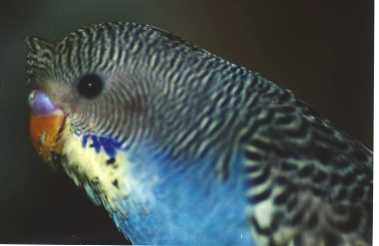
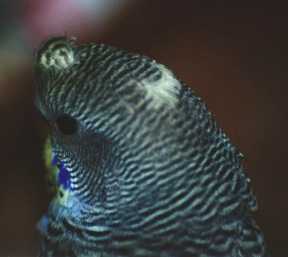
This page is dedicated to Stella Bennett, Crestie's owner.
Let's look at the gene for making budgie crests and tufts. Normal budgies have head feathers that lay down smoothly, and if the budgie raises its head feathers, the feathers raise up smoothly. Tufted or crested budgies have a disturbance in the nice neat head feathers. It can be a mild little disturbance that just makes a few feathers stick up all the time, or it can be a large disturbance that makes the bird look like it's got a permanent Bad Hair Day.
This budgie has a small but well-formed, semicircular crest. The budgie below has just a tiny, not-well-formed feather disturbance that barely qualifies as a tuft:
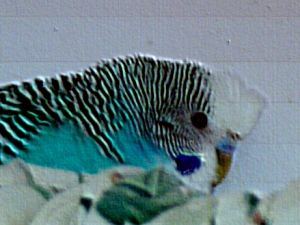
To see an English budgie with a full circular crest, take a peek here.
There is only one gene needed to make all the different types of crests: full (circular) crests, half (semicircular) crests, and tufts. A budgie with any of these types of crest can produce offspring with any type of crest, or produce offspring with no crest at all. Therefore, when a crested bird has a non-crested baby, we don't say the baby is "split" to crested. We say it is "crest-bred"
The gene doesn't act like a regular dominant or recessive gene. You are better off memorizing or copying down what actually happens. Here is what you can expect, more or less, when you are breeding crested birds:
1. Crested X Crested will produce 70% crested birds.
2. Crested X Crest bred will produce 40% crested birds.
3. Crested X Normal will produce 10% crested birds.
4. Crest bred X Crest bred is a waste of time.
5. Crest bred X Normal also a waste of time.
In all the above pairings the crest type produced is usually:
15% (about 1 in 7) full crest,
30% (about 2 in 7) half crest,
55% (about 4 in 7) tufted.
Many thanks to Andy Vogt for the statistics on crested budgies.
Okay, so let's make sure we understand what that means. A real life example would be good. The first budgie shown on this page belongs to a friend of mine. It's the only crested budgie she has. What can she expect when she breeds it?
Obviously, if it's the only crested bird she has, its mate will be normal. This corresponds to situation #3, "Crested X Normal". We see that "Crested X Normal" yields 10% of the babies as crested. That is the same as saying one out of every 10 babies, on the average, will show some sign of a crest.
With an average clutch size of 5(which is reasonable), it will take my friend about two clutches of babies to get one crested baby to show up. That's on the average. If my friend is unlucky, it could take more than two clutches for a crested baby to show up. When a crested baby DOES happen, it is most likely to just be tufted -that happens 55% of the time, as we can see.
What would it take for my friend to get a fully crested baby? Well, on the average, only one of every seven crested babies is fully crested. Therefore, she might need fourteen clutches of babies to get that one fully crested chick! And if she is unlucky, it could take even more! Could she possibly be very lucky and get a fully crested baby in the first bunch? Sure. Should she bet on it? Nope. Could she get a whole clutch of crested babies? Sure, though it's unlikely.
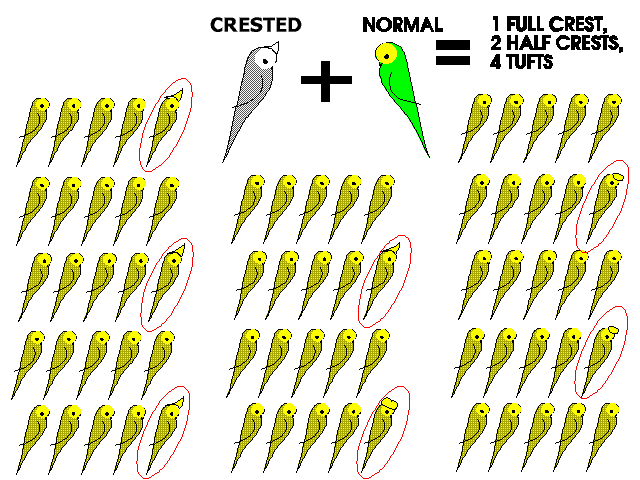
Now, a second real life example. I own the second budgie shown on this page, the one with the teeny little tuft. It's my only crested budgie. What are my chances of getting a fully crested baby? Here again, we have the "Crested X Normal" situation we just examined. My chances of getting a fully crested budgie are the same as my friend's, even though her bird has much more crest than mine. Doesn't seem fair, does it?
A third example: if my friend and I were to team up, we could have "Crested X Crested", situation #1. Then, 70% of the babies would be crested! That means we'd have three or four crested babies in every clutch, on the average. It would take us about two clutches to get a fully crested baby, rather than fourteen.
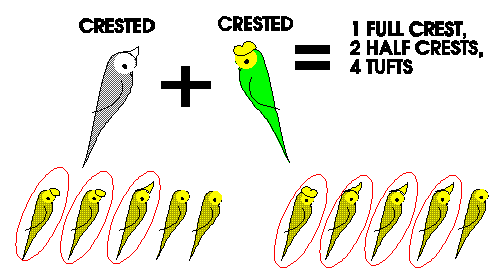
A fourth example: My tufted bird is male. My friend's bird is a baby. Suppose it turns out to be male, too? Then we can't breed them to each other! What would be our best bet for fully crested kids? Well, we could each breed our crested birds to normal hens. The babies would be "crest-bred". We could swap female baby crest-bred budgies, wait for the babies to grow up, and mate them with the males. Then, we'd each have a "Crested X Crest-Bred", which is situation #2. Forty percent of the babies is about two crested babies in each clutch. In order to get that one-in-seven fully crested baby, I would have to breed my new pair about three or four times (less if I'm lucky, more if I'm unlucky).


But with budgies and cockatiels, equal amounts of boys and girls do appear, overall (someone correct me if I'm wrong here). Therefore, if you get a clutch of six babies, you are almost guaranteed to have at least one male and one female. It would be very rare for all six babies to be males, or for all six to be females.
How do I know this? Because I have suffered through semester after semester of college statistics courses. Can I prove that six is the magic number? Yep. But I'm not gonna. If you are very interested in statistics and have a masochistic streak, you can learn more at your local college.
This magic number of six babies works with other things besides sexes. If you have a dominant pied poppa with only one pied gene, and a solid color momma, you will expect to get pied and solid babies in equal numbers. (Poppa gives either his pied gene or it's matching non-pied gene, equally often.) So we would predict that in any clutch of six or more babies from these parents, we would have at least one solid colored bird and at least one pied one. If your favorite niece had her heart set on a pied budgie and you got six hatchlings, you could promise her a pied budgie even before the babies begin to show feathers.
Another real life example: you go to a bird fair and someone is selling immature buttton quail. They're so cute you can't stand it and you decide you want some. If you want to be sure you'll have a breeding pair someday, how many do you buy? That's right, six! Sure, maybe you'll get three pairs. But you could also get four of one sex and two of the other, or five of one sex and one of the other sex. It would be VERY rare to get all six of one sex. If you only buy five quail, you might get lucky and get one or two pairs, but it wouldn't be all that rare for you to get five of one sex.
Remember, though, that the six birds have to be random. What do I mean by that? You can't pick them out based on anything. For example, if there is a huge cage full of budgies of all different colors, and I choose out six lutinos, is it random? No! I did not pick six random budgies; I SELECTED lutinos. That makes it non-random. My selecting may have spoiled the randomness of my six budgies. In fact, lutino is a sex-linked trait, so I've selected for females.
